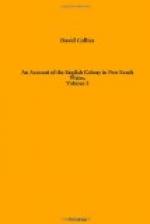On arranging their courses and distances on paper, they appeared to have travelled in a direction SW three-fourths W about 140 miles from Parramatta. They brought in with them one of the birds which they had named pheasants, but which on examination appeared to be a variety of the Bird of Paradise.
The size of this curious and handsome bird was that of a common hen; the colour a reddish black, the bill long, the legs black and very strong. The tail, about two feet in length, was formed of several feathers, two of which were the principal, having the interior sides scalloped alternately of a deeper or lighter reddish brown inclining to orange, shading gently into a white or silver colour next the stem, crossing each other, and at the very extremity terminating in a broad black round finishing. The difference of colour in the scallops did not proceed from any precise change in the colour itself, but from the texture of the feather, which was alternately thicker and thinner. The fibres of the outer side of the stem were narrow and of a lead colour. Two other feathers of equal length, and of a blueish or lead colour, lay within those; very narrow, and having fibres only on one side of the stem. Many other feathers of the same length lay within those again, which were of a pale greyish colour, and of the most delicate texture, resembling more the skeleton of a feather than a perfect one. The annexed engraving, from the pencil of a capital artist, will give a better idea of this beautiful bird than can be formed from any description.
A general muster took place on the 14th in every district of the colony, at which every labouring man, whether free or convict, was obliged to appear. On the following morning the settlers were called over, previous to which, the governor, who was present, informed them, that he had heard of much discontent prevailing among them in consequence of certain heavy grievances which they said they laboured under. For these, as he was unacquainted with the nature of them, he was unable to suggest any remedy; he therefore desired that they might be represented to him in writing; and, to spare them as much trouble as possible, he would direct two gentlemen on whom he had much dependance to visit the different districts, and collect from the respective settlers such of their distresses and grievances as they were desirous of making known. Before they were dismissed, he gave them much good advice; and assured them, that he had already, from his own ideas, offered a plan to the secretary of state for their benefit, which he hoped would in due time be attended to.
After these, the women and children were mustered, and were found to compose a very considerable part of the settlement.
With the ripening of the maize fields, the depredations of the natives returned. On the 19th the governor received a dispatch from Parramatta, containing an account, that a man had been murdered by them near Toongabbie, and three others severely wounded; and a few days after two others were killed in the same manner. It became, from these circumstances, absolutely necessary to send out numerous well-armed parties, and attack them wherever they should be met with; for lenity or forbearance had only been followed by repeated acts of cruelty.




